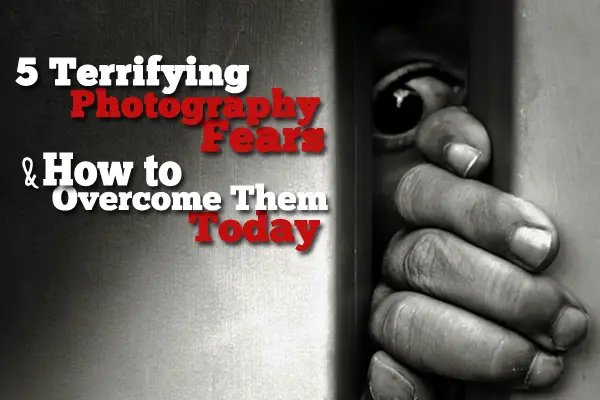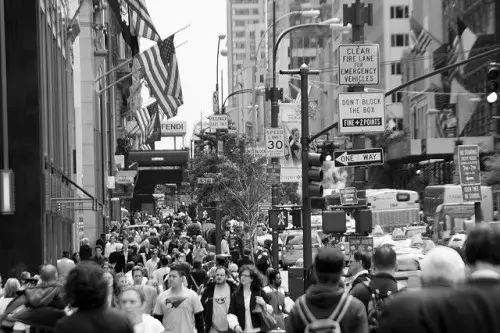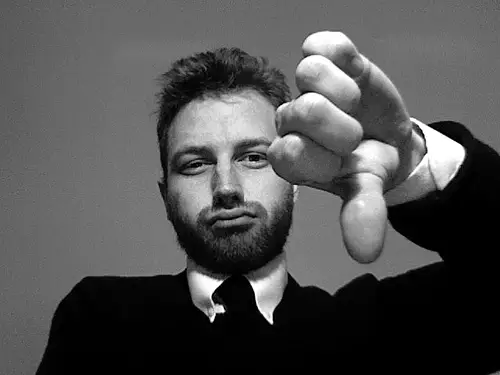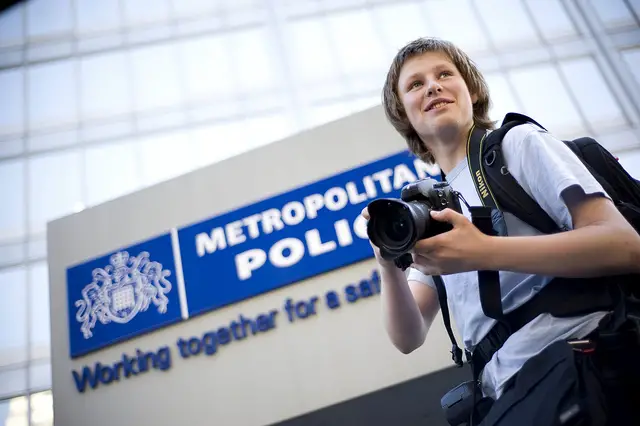You’re walking down the street, sleek camera in hand. As luck would have it, a photogenic girl crosses your path, stopping at the curb long enough to pull her hair back. She is silhouetted against the glowing city light; this is the perfect photographic moment.

You reach for your camera, frame the shot, and…she’s gone. You didn’t hear the click of the shutter before she walked away, because you never pressed it. What just happened?
Fear, my friend. Fear.
It didn’t have to be that way. The fear of photographing people in public, as well as many others, can be overcome. As with most problems we face, it’s simply a matter of identifying the issue, and applying a corrective action. Next time, you don’t have to miss the girl walking across the street.
Photography, in general, is not a team sport. Photographers generally work alone, throughout the shooting, processing, and other decision-making. We have to promote ourselves in order to differentiate our work from the rest of the pack, and in that process, learn a little about what we’re afraid of in regards to our photography.
The Brazilian author Paulo Coelho once said,
“There is only one thing that makes a dream impossible to achieve: the fear of failure”
While this can be applied to many things in life, it makes great sense to us as visual artists. Photography is an area that not only rewards passion and dedication, but creativity as well. There is infinite knowledge to be absorbed about the craft, and you’ll constantly be learning new things. People simply fear what is new and different.
While identifying your fears is important, so is recognizing what steps you can take to minimize them. So let’s identify some of the most intimidating aspects of photography, and what we can do to overcome them.
1. Shooting in Public
Personally, I’m an introverted person, and even outside of photography, trying something new and “grabbing the moment” is a challenge. When I’m shooting in public, I tend to worry about the people around me, thinking “Are they wondering what I”m doing here?” or “Are they afraid I’m going to take their picture?”. The reality is, people generally aren’t worried about what we’re doing at all, although we don’t realize it at that point.

Even if you’re not involved in street photography, chances are, you won’t be completely alone wherever you’re shooting. So regardless of your situation, this is a fear you’ll need to overcome quickly so you can be comfortable with what you’re doing.
Digital Photography School has a great article on dealing with street photography fears, which can be found here.
What can I do?
- Familiarize yourself with your rights as a photographer. Some fear may emanate from the possibility of infringing on someone else’s space or property, and being called out on it. Knowing where you can and cannot shoot will give you confidence in this area.
- The best way to conquer a fear is to face it head on, so if taking photos in public makes you cringe a bit, force yourself to do it often. Make it a point to go downtown or to another more populated area and walk around looking for shots.
- Focus on the subject of your photos, whatever that may be. Concentrate on what you’re trying to accomplish, what camera settings you’ll need to reach that goal, and anything else that takes your mind off of the people around you. When you’ve become comfortable with this, you can move on to taking photos of the people themselves.
2. Failure
Although I am not yet a professional photographer (and there’s no guarantee I ever will be), I am already thinking ahead of the challenges I’ll face. The trade requires you to be creative, technically adept, and an able businessperson. It also seems a hint of luck is involved. If we spent all of our time worrying about the infinite ways we could fail, we’d probably rethink our decision of getting involved with photography altogether.

Even as a hobby, we hold ourselves to a certain standard. We want our photos to turn out the way we had envisioned them in our minds, and we not only want to be happy with the results ourselves, we want others to think highly of them as well, especially those whose opinion we hold in high regard. Of course, it’s impossible to always be happy with your work, and even less likely that others will always hold a positive opinion on everything we do.
What can I do?
- Realize that failure isn’t always the worst-case scenario; failure can be beneficial as a teaching tool. Every mistake you make results in a lesson learned. Even if you don’t succeed, you have invested time in what you love to do, and you have gained experience.
- Use your fear to improve your final product. By nature, fearing the result of a situation forces you to think more completely about what you need to do to succeed at it. This can only help you focus on what’s important, and making the right decisions.
- Educate yourself on how failure didn’t stop others from their ultimate goal. A quick search on the internet will give you plenty of examples of historical figures that experienced adversity and failure, only to eventually reach their goal, in spectacular ways. Abraham Lincoln, Walt Disney, and Steve Jobs are just a few examples.
3. Dealing with People
People can be classified into two general types, introverts and extroverts. While extroverts are comfortable with communicating and socializing with other people, introverts have trouble getting that line of communication open, and in rarer cases avoid other people as much as possible.

It’s hard to go through life this way, since your inherent fears are often misunderstood for arrogance or unfriendliness. Add a profession like photography to the mix, and things get really tough. Unless you are planning to solely generate your income as a landscape stock photographer (which will be extremely challenging), you’re going to need to interact with others. There are a few things you can do, however to ease the apprehension you feel when you need to communicate with clients.
What can I do?
- Know your stuff, inside and out. One subconscious fear a lot of us have is misspeaking or not knowing important information, such as technical knowledge about what we do. We want to look professional, and a good way to do that is to be experts at the services we’re offering. Learn all you can so that you’ll be able to answer any question a client has, quickly and accurately.
- Keep in mind that you are serving a purpose to a client, and communicating with them effectively is part of how you serve that purpose. This can help keep the big picture in focus.
- Put forth your best effort. If this is a new client, doing a great job will keep them coming back, and communication will always get easier as the business relationship develops.
4. Rejection
Unfortunately, rejection is a part of life, and it’s no different with photography. There are many ways you can experience it in this field. A client disliking image proofs you’ve given them, a stock photography site rejecting shots you’re uploaded, even family and friends giving constructive criticism on photos you’ve shown them.

The key point to remember with rejection is, it’s completely unavoidable; in many situations, there’s nothing you can do about it, and regardless of how well you know you’re equipment, your client, and your craft, rejection is bound to happen at one time or another. The best way to prepare for it is to educate yourself on how to accept it and turn it into a positive learning experience.
What can I do?
- Resist the urge to immediately think the problem is your photography. As a photographer looking to generate revenue from your work, it’s certainly important that clients and other people in certain positions like your product, but in the end, as photography is art, what you think of it is infinitely more important. Tastes are wide-ranging in people, and photography is inherently subjective; any shot you are happy with has the potential to be accepted by others.
- Grow tougher skin. As we learned earlier, there is no way around rejection in this field. Keep in mind that you will encounter this, particularly in the beginning. Make every rejection a learning experience. This will keep the rejections down in the future and bring about more successes.
- Communicate effectively. Sometimes rejection comes from initial miscommunications. Be honest and up front about your pricing, quality of work, and timelines. Don’t try to impress the client by promising something you can’t deliver. By being as transparent as possible in your business, you’ll give yourself an important advantage that can help keep the chances of rejection down when the shoot or project is complete.
5. Trying Something New
Many of us have a fear of trying new things. It’s just natural to us to stick with what we know, what we’re good at, and what we’re already comfortable with. Of course, doing this doesn’t allow us to grow in whatever we’re doing, and this applies to our photography as well.

Even for a hobbyist, breaking out and exploring new things has advantages. For professionals it’s even more important, especially if your scope of work is multifaceted and you flip back and forth between multiple disciplines of photography. Although this fear is usually not as scary to us as some of the others, it can be just as important to conquer.
What can I do?
- Try a new type of photography. Whether you intend on working in a particular discipline or not, it’s always a good thing to experiment anyway. If you’re stuck in a rut with landscape photography, grab a friend or your kids and try taking portraits for the day. Change to a macro lens and practice shooting food shots. Throwing yourself a curve ball is a surefire way to grow!
- Experiment with new gear. One of the safest ways to break out of your shell is to go a different route in regards to your equipment. Go rent a fisheye lens for a weekend, or force yourself to only shoot with a smartphone for an entire day. Experiment with alternative techniques; searching the internet will result in tons of new things to try, such as using a sandwich bag as a filter, or creating a unique bokeh effect by crafting a DIY lens cover.
- Make a list. Make a list and keep it easily accessible, perhaps in your camera bag. On this list, write down everything you can think of that you haven’t tried concerning photography. Lenses, camera types, post-processing, techniques, locations, everything. Make a habit of checking the list every now and then, and use your off days to pick an item, try it, and scratch it off the list. When you think of something new you haven’t attempted, add it to your list for the future. We usually do better with tangible things, so this is a good way of keeping yourself honest about what you have tried, and what you haven’t.
Hopefully some of what we discussed will help you along in dealing with your photography fears. The most important thing to keep in mind is that we all deal with them from time to time, and that regardless of what they are, we can turn them into positives and use them to our advantage.
We aren’t photographers because we have to be, we’re photographers because we want to be; we get an enjoyment and sense of pride and purpose out of it, and keeping that in mind can help quell the mental roadblocks we encounter along the way.
Do you have a fear that we didn’t discuss? Let us know by submitting a comment below! And when you’re done, bolster your confidence a little more by reading 8 Tips for Working with Models Every Photographer Should Know.









I think one of my fears is being mugged. I sometimes don’t feel comfortable walking in some neighborhoods while carrying $1500 worth of equipment, and had to give up those locations.
Exactly Kevin, you either have to go in with your backup camera and possibly not get the shot you were looking for, or forgo the location altogether.
Great post, Tim.
I think we’ve all had some of these fears popup at some point.
Thanks Patrick, I agree, and a couple of them might stick around permenantly!
There is the in-your-face approach which consists of not considering people and shooting what ever you want, any time. I know photographers like that, that don’t mind putting their lens right in front of the nose of strangers. I hate it, not only because I am afraid, but because I wouldn’t want it done to me. You have to be very close to do an intimate portrait of a stranger with a 35mm.
If you don’t have that kind of confidence (or consideration for others), you may walk fast, stop for 1 second, take the shot and run. That’s when people feel invaded the most, like if the photographer stole something from them. All you might have gained, is a lesser feeling of shame because less people spotted you.
Then there is the more respectful approach. You can ask, talk to your subject, but that may not practical all the time and may kill the moment. One thing I learned is that if you stick around long enough and do not look like you are hiding something, people eventually get used to your presence and accept the fact that you are taking pictures. They may even get curious after a while and hope for you to take a shot. And if some stranger passes by quickly, you feel ok to take the shot because you feel good in this spot, you “own” the place and the other people around, now accepting your presence, will not mind it. This is similar to point 2 in the digital photography school article.
This has a great advantage, you find a great spot where you know you will have a great background and more chance at a successful composition. Then wait for the perfect subject. Many great street shots were taken this way. Running around does not help you finding good locations.
Thank you for the comment André, I’d tend to agree! I’m also one of those people that don’t care for having my photo taken, so I can empathize.
Also, street photography doesn’t have to involve strictly portraiture, of course. Taking shots that contain random strangers is totally possible without focusing on an individual, and I find those can be more spontaneous in nature, as well as less straining on the subject as well as the photographer.